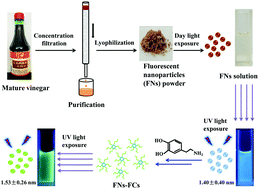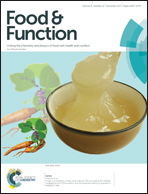Fluorescent nanoparticles from mature vinegar: their properties and interaction with dopamine†
Abstract
Naturally occurring nanoparticles may be present in food. In this paper we report the discovery of fluorescent nanoparticles (FNs) in Chinese mature vinegar. The physicochemical properties of these FNs were investigated. The FNs were shown to emit bright blue fluorescence under the irradiation of ultraviolet light, with a fluorescence quantum yield of 5.71%. They are highly soluble in aqueous solution, and exhibit excitation-dependent emission behavior. TEM characterization showed that the average size of FNs is about 1.40 ± 0.40 nm, and the morphology of FNs is mainly spherical. The physicochemical properties of FNs are similar to those of artificially synthesized carbon dots. Furthermore, the interaction between FNs and dopamine was studied, and the fluorescence of FNs varied gradually from a blue, to a cyan and finally to a green color with increasing dopamine concentration. The fluorescence decay dynamics revealed that Förster resonance energy transfer (FRET) occurred between the FNs and polymerized dopamine. This result suggests that the FNs from Chinese mature vinegar can interact with dopamine, which may add a new perspective to the potential health implications of foodborne nanoparticles.



 Please wait while we load your content...
Please wait while we load your content...